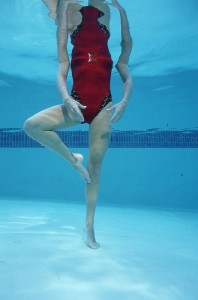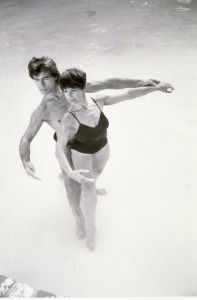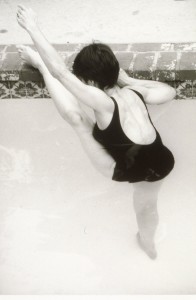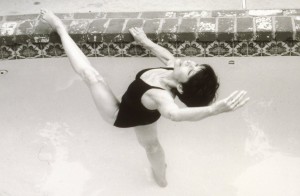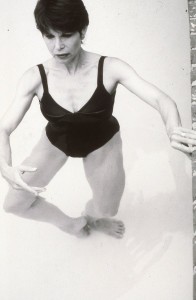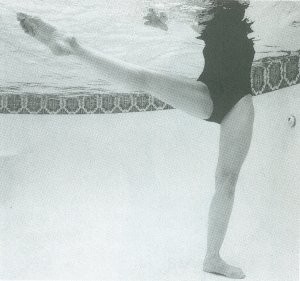Dancers are athletes as well as artists. As they work to defy the laws of physics during practice or performance, their finely tuned bodies are constantly in danger of an accident or momentary loss of control or weakness. So like all athletes, they must work to remain strong while doing everything possible to prevent overuse injuries.
Dance-specific pool workouts allow dancers to add training hours to their regiment because their extra leaps, bounds, and jumps use water as a landing cushion, sparing their bodies extra trauma. Dance pool sessions can also be used instead ofregular practice sessions. Whenever a small strain or pain makes a dancer leery of working at full speed or power in the studio, the practice session can move to the pool.
I worked for many months with premier dancers, USC teachers, and Hollywood choreographers Bill and Jacqui Landrum. I taught them how to use the pool and they taught me their dance moves. Ballet dancers normally execute their moves in a turnout position of the feet and legs that can often lead to complications of the knee and hip joints. But dancers who used our pool program reported that doing the exercises in both turnout and parallel positions helped them create a more balanced strength in the thigh, buttocks, and hip area – and that meant less pain in the hip and the knee. So we did half their repetitions of exercises in the turnout that felt so natural to them and the other half with feet parallel, a position that made them cringe at first, but they soon learned to appreciate because it reduced muscular stress and pain.
The following examples of Bill and Jacqui’s exercises show the basic idea. For in-depth details, see Chapter Four of The Complete Waterpower Workout Book.
Before each session, dancers should sit on the side of the pool and perform ten ankle circles in each direction. In the water, the warm up can be done in either deep or shallow water. The shallow-water program includes various jumps while the deep-water program simulates running and walking moves that become more graceful when modified for dancers. Injured dancers should start in deep water to avoid all impact. (A flotation belt is needed for the deep-water exercises.)
After the warm up, all dancers go to the side of the pool for an extended stretch and barre work. The Waterpower Book includes pictures of Bill and Jacqui doing Fourth and Second-Position Extended Bar Stretches, Demi-Plié and Grand Plié, Tendu, Dégagé, Passé, and Grand Rond de Jambe en L’Air. That last exercise becomes easier on one hand because of the buoyancy that lifts the leg, but becomes harder on the other hand because of the constant water resistance throughout the entire circular motion of the leg. Great strength can be created for such a move, especially when a resistance cuff is added at the ankle. The dance pool session continues with Fondu Développé Relevé, Battements, Echappés, and many others.
4th Position Extended Barre Stretch
Fondu Développé Relévé
Grand Rond de Jambe
To round out the session, dancers can put together a series of dance moves that please them and at the same time strengthen specific areas of the body. Next come specific dance moves to help retain timing. Repeat that series five times in one direction, then five times in the other.
Lynda Huey, M.S., founder of CompletePT and Huey’s Athletic Network, is a former athlete and coach whose own injuries led her into the water to find fitness and healing. She was educated at San Jose State University where she starred on the track and field team during its golden years. Lynda is the author of four books on water exercise and water rehabilitation.


